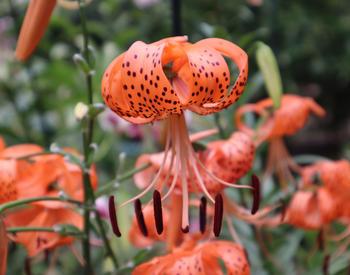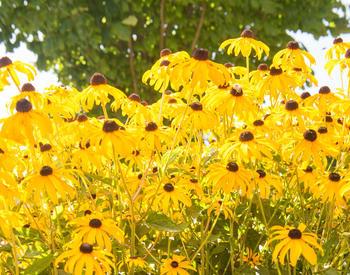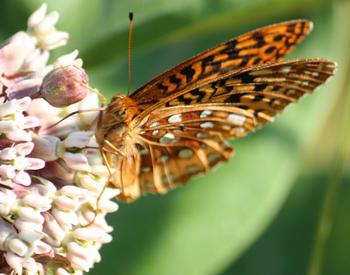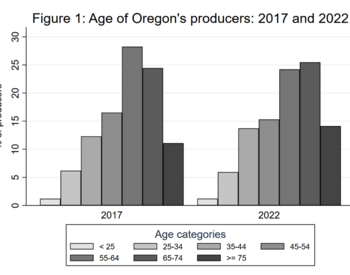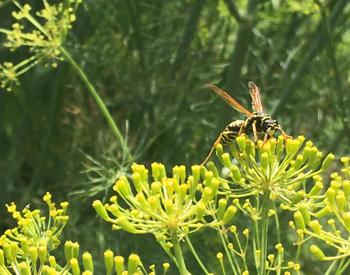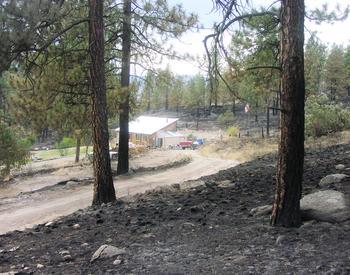Transcript
Audio file
Transcript
Speaker 1
From the Oregon State University Extension Service, this is pollination, a podcast that tells the stories of researchers, land managers, and concerned citizens making bold strides to improve the health of pollinators. I'm your host doctor Adoni Melitopol, his assistant professor in pollinator health in the Department of Horticulture. I'm really pleased to speak to invite a guest host, Maggie Graham. She's a Master of Science candidate here at Oregon State University in the water resources and science program. She's going to have a conversation with John Jacob, a beekeeper from says in Oregon about solar panels and bees. I hope you enjoy the episode.
Speaker 2
We're here with John Jacob, Rogue Valley beekeeper of 23 years and president of the Oregon State Beekeepers Association. Welcome to the show, John.
Speaker 3
Thank you for having me.
Speaker 2
Solar energy and bees aren't topics you'd necessarily expect to hear about together. Tell us how they intersect.
Speaker 3
For me, they first started to intersect over land use issues. A lot of solar companies were having difficulty. Be getting their sites approved on farmland because they were going to be taking the land out of farm use and I saw honeybees to maintain legal farm use and keep or create a lot of pollinator habitat in in the same stroke.
Speaker 2
And so, you have one of these sites in Rogue Valley. Can you tell us a little bit about that project?
Speaker 3
This project is the first site that we got these on. We have three more pending, but it's a collaboration with the Pine Gate Renewables and. They planted a bunch of native blooming species and invited me to bring my bees out. They were not required to keep up farm use there, but they just like the idea of doing that and they understand, as many people do, that their habitat loss is one of the drivers of loss of pollinators in general, not just honey.
Speaker 2
Tell us a little bit more about the site, how big it was when it was established, or how the site was prepared.
Speaker 3
The site, as far as I know, has completed construction. Last year. It was last year was the first year we put bees on there. It's being planted in sequential steps. There were some plantings last fall. There have been some plantings this spring, and there are more plants the company doing the planting is a consultant company called Understory and their specialty is native plants. So that's really unique about this site. Not all sites will be just native. Plants. So that's an extra challenge, but it's also really nice because I think it'll be really good for the native pollinators as well as the honey.
Speaker 2
Bees. Why is pollinator-focused solar important for pollinators in the Rogue Valley?
Speaker 3
Well, I think it's for important for pollinators everywhere, not just the rug. Really, the need for electricity only increases and solar is growing very rapidly. It's one of the fastest sectors of growing sectors of renewable energy and you know, as we have faced declining pollinator habitat, this is an opportunity to use. A lot of prime land for. The benefit of pollinators? This is hopefully a model that would be adopted far and wide, not just here in Southern Oregon.
Speaker 2
Speaking of local adoption, are there any other sites like this locally or is this the only one in the area?
Speaker 3
We have another site that I'm expected to bring bees out to this year and then we have two more sites just outside of Portland, Portland, and Clackamas County. And from what I gather, there are five gigawatts of solar plants for Southern Oregon and the dual-use model will maximize the amount of acreage that is allowed.
Speaker 2
Can you tell us a little? But more about why. Habitat for pollinators is needed in the area.
Speaker 3
Well, our food supply is really dependent on pollinators. You know, there's the old statistic that one-third of every bite that you eat is attributed to insect pollination. I think that's only true if you're eating a really poor diet. If you're eating a really healthy diet, you're probably eating 50%. There are more insect-pollinated foods and. Habitat is disappearing. For pollinators that's driving you know, the 6th extinction. It's called the insects are disappearing very, very rapidly right now, and habitat loss is one of the drivers. I see utility-scale solar as a solution because there's a lot of ground that's in and around the solar panels that could be converted to habit. As an example, here in Southern Oregon, the hemp industry this last year has planted 48,000 acres (about twice the area of Manhattan) of hemp, which is a huge monoculture. Monocultures are not very good for bees because it's an unfloral source, and it's also a wind. Hemp is a wind-pollinated plant, so it makes no nectar. So, fields that I used to be able to make honey contained various clovers thistles, and vetch. I mean, the list goes on and on, and like what? Nectar-bearing plants have disappeared and this is a challenge not only for managed honeybees but also for our native pollinators.
Speaker 2
Thanks, John. With that, we'll take a break and we'll be right back with more pollination. All right. And we're back here with John, and Jacob talking about pollinator-focused solar. Next question for you, John, tell us a little bit more about your bees at the Eagle Point site and the establishment there, were you, did you have any hesitations about putting your bees? There initially.
Speaker 3
No, absolutely 0 hesitation. It's a very unique and exciting opportunity to have some ground that's actually managed for pollinators. This is a very rare thing, and you know the biggest challenge I've found is just getting people to recognize that honeybees are illegal farm use. They're defined as livestock and Oregon State law. And it's just a great opportunity to have a significant amount of ground. That's these projects. We're managed for 30-year increments, so that's a long time to lock up some premium ground and pollinator habitat.
Speaker 2
So, I noticed you said this. This site is managed specifically for pollinators. How does that? How does that differ from other locations where you have your bees?
Speaker 3
Well, we have two types of locations that we would bring ours. Bees to a lot of them are what I call wildlands and you just get what you get, and those tend to be some of our best yards because they're not sprayed and they're not just the ground. The ground is not disturbed.
Speaker 2
Like a forest.
Speaker 3
Forest lands tend to not have the most nectar-bearing plants, but you know like oak Savannah, where there's a lot of vets and you know that urban-wildland interface tends to be a really good spot for bees because there's a. Stuff that gets irrigated and then if you get lucky and the weather is nice that there's good wildflower flows. Another thing I really like about This site is that there's zero insecticide use. Yeah, they, they. Well, and to go back to what I was saying before, the other type of land we go to is. Paid pollinations. Where we do come in contact with insecticides. And fungicides, and there's a lot of known risks and hazards to honeybees and wild pollinators from these sprays. To have a decent chunk of ground that's not getting inundated with these chemicals is a huge upside.
Speaker 2
So paid pollination sites, does that mean, like someone's growing a crop and then you're paying a fee to put your fees on the site? Tell me a little.
Speaker 3
But more about that. Well, it's the opposite. It is a crop. But they pay us to bring Arby's. And you know for. Example we. Get paid to bring our bees to the almond pollination. In California, we get about $210.00 a colony and. Part of the reason why pollination prices have gotten so expensive? You know, when I started in 2000, we were getting $40 a colony and just this short, 20-plus year period. You know that that's a huge increase and that's due to scarcity. That's in part because of keeping honeybees. Live is incredibly difficult. Next to the Varroa mite, which is our probably number one problem, but you know habitat loss. And agricultural sprays are probably the next two biggest things. So, these solar sites are really important because they're like an Oasis or a. But it's a preserve, you know, pollinated, preserve, essentially or potentially.
Speaker 2
Do you think the installation of more sites like this will increase in Oregon or do you think this kind of is the only one? What should we do? What do you think we'll see in the next 10 years in this? Field in Oregon.
Speaker 3
Well, Oregon's passed some rules that are going to make it more challenging for solar on farmlands. But I think at the end of the day, we're going to see this model adopted far and wide because land is precious, you know, and habitat is disappearing. At the end of the day, food never goes out of style, so by protecting pollinators, we're protecting our food supply and we're looking after our best interest and I think ultimately, I have faith that, our fellow humans will understand that. And you know, as climate change becomes more urgent and. This will create an incentive to use more renewable energy that's going to take up some ground and we could use that ground for pollinator habitat. I think it's a great mix.
Speaker 2
Have you looked into any pollinator sites on wind or any other type of renewable energy site?
Speaker 3
Not too much, mostly because we don't have wind farms here in Southern Oregon, but I do know that. There's a lot of farming that does go on around wind turbines, you know, they're way up in the air and out of. The way and you know. It's a little easier for people to conceive of farming that ground. You know, a lot of times. That is one of the challenges we face. People just don't believe you can farm in and around these solar arrays, but there are people who graze sheep. We've got tractors that we can run in there, I mean. The only limitation is the creativity of the farmer and being able to select the right seeds and species that will love the slightly shadier environment.
Speaker 2
Did I hear that right? Did you say that you're able to use a tractor underneath them? Solar panels.
Speaker 3
Yes, understory does have a small tractor they use there and some things can be done to accommodate small farm equipment in there like spacing the panels further apart and mounting them higher up. It just takes good planning on the front end of the developer to really think about the dual-use model, where they're going to plan so that you know you can get farm equipment in between the panels.
Speaker 2
Are there any other ways that you have to modify a typical solar array in order to plant pollinator habitat? We have a dual-use agriculture system below it.
Speaker 3
I don't really think so. I mean the height and the spacing are the two biggest things and then you know other than that it's just like farming. Like what is your soil type? How much precipitation do you get, you know, there's been some great work done at OHSU that talks about. The extended period of soil moisture to the shade, and so will allow the selection of certain forage crops that might not have been viable before because things stay moist longer and you get extended blooming periods and things like that.
Speaker 2
We're talking briefly about the extended bloom period there. How does how might that change under a solar system?
Speaker 3
Well in my mind that would be more days of nectar foraging. You know, there's some good science that needs to be done. If the bloom period is extended by two weeks. Or three weeks because it takes that much longer for the soil to dry out. Is the water content of the nectar the same or not? But at the end of the day, I see this dual-use model as about the only way honeybees and pollinators and native pollinators, in general, will ever get Prime Farm ground dedicated. Then, you know, beekeepers are used to getting stuck with the drags. You know, the ditch. That got missed on the spray fence line where they couldn't get the spray equipment to and. You know, as I said before, honeybees are legal farm use, and for once, maybe we can get some premium farm ground dedicated to growing some premium honeybees.
Speaker 2
Great. Thank you, John. We're off for another break and then we'll be back to ask John, our three favorite questions that we ask every interviewee to come back and join us on pollination. All right, we're back here on pollination with John Jacob. And we have three questions for you, John. We asked this to every guest on our show. The 1st is, do you have a book recommendation for the listeners today?
Speaker 3
The book that I would recommend to everybody, beekeeper or Not, is the social democracy of the Honeybee Hive by Thomas Seeley. It's just a fascinating study of a social insect that has been around, you know since dinosaur times. You know, it has been around a successful Organism. Before humans. Plus, Tom's work the way he does. Does his experimental design, his bar? None. It's just really fascinating to see how he solves these mysteries of the honeybee hives, so I'd really recommend it. That book.
Speaker 2
Great. Thanks. And next question, what is your go-to tool that you use in your work?
Speaker 3
That would be the hive tool and specifically, I like the Pro lifter hive. Tool. Not. To endorse a particular one, but we break a lot of hive tools, and I've never broken one of these. The Hive tool is essentially the key to the Kingdom. You know this glue everything down with propolis, so you have to pry everything apart and these boxes can weigh 100 pounds apiece, and they're glued together with propolis. You need. You need a stout tool to separate those boxes, so the hype tool is the key to the B Kingdom.
Speaker 2
For people who don't know, can you tell us what a hive tool looks like?
Speaker 3
It's like a flat bar. It looks like a pry tool. You know, it's kind of, yeah, it's. It's sharpened on one edge to split the boxes apart. Propolis is a resin plant that gathers from trees. As it turns out, they gather from trees and other plants, but around here mostly Cottonwood trees, but it's highly medicinal. And it's also how they seal the hive. And it also makes it very difficult to get into the hive, they just glue everything down.
Speaker 2
Wonderful. Thanks. And our last question, what is your favorite pollinator?
Speaker 3
Well, I guess I would have to say the honey. Bee. But you know I have a hard time singling out one. You know, I plant a lot of plants just to attract native pollinators that don't really attract honeybees, but. The honeybees are very fascinating and the evolution of the relationship between humans and honeybees goes back so far, and it's just a fascinating history there, and there's such a linchpin in our food supply, and it's really hard not to just absolutely love the honeybee.
Speaker 2
Wonderful. Thank you, John. We appreciate your time and thank you for telling us about Polair-focused solar here. In the Rogue Valley.
Speaker 1
Thanks so much for listening. Show notes with information discussed in each episode can be found at pollinationpodcast.oregonstate.edu. We'd also love to hear from you, and there are several ways to connect, but once you can visit our website. Post an episode, specific comments suggest a future guest or topic or ask a question that can be featured in a future episode. You can also e-mail us at the pollination podcast at oregonstate.edu. Finally, you can tweet questions or comments or join our Facebook or Instagram communities. Just look us up at OHSU pollinator health. If you like the show, consider letting iTunes know by leaving us a review or rating. It makes us more visible, which helps others discover pollination. See you next week.
There is a lot of ground under solar panels that could be planted to pollinator habitat. In this episode guest host Maggie Graham (MSc candidate, Water Resources Science, OSU) talks with John Jacob, a Southern Oregon beekeeper, who has been working with solar panel companies to make sure new installations include habitat for bees.
John has run Old Sol Apiaries in Medford, Oregon since 1997. He is also the current President of Oregon State Beekeepers Association.
You can Subscribe and Listen to PolliNation on Apple Podcasts.
And be sure to leave us a Rating and Review!
Links:
- Nation’s largest solar bee farm in Oregon (Bee Culture, July 26, 2018)
- Pine Gate Renewables
- Old Sol Apiaries
John’s favorite book: Seeley, Thomas D. Honeybee democracy. Princeton University Press, 2010.
John’s favorite pollinator: honey bee


